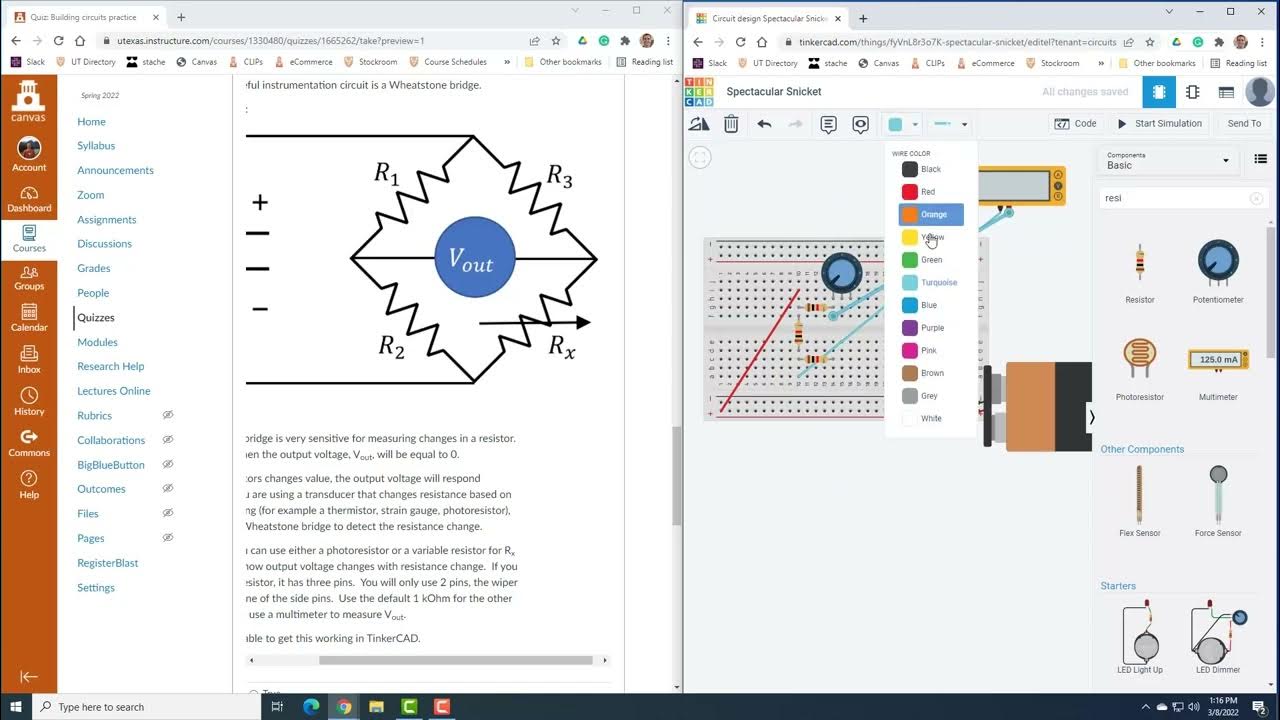Class AB Output Stage: Biasing Using a VBE Multiplier
Summary
TLDRThe video discusses the VBE multiplier circuit used for biasing a Class A V output stage. The circuit includes output transistors (QN and QP), a transistor (Q1), and resistors (R1, R2) forming a voltage divider. The speaker explains how the VBE multiplier provides a stable bias voltage (VBB), controlled by the resistor ratio. This scheme offers better stability than a series diode configuration due to a small variation in VBE, even under high load current. The exponential relationship between collector current (IC) and VBE is also explored using Shockley's equation.
Takeaways
- 🔧 The VBE multiplier is used as a biasing scheme for the Class A V output stage.
- 🔋 The circuit consists of output transistors (QN and QP), a bias transistor (Q1), and resistors (R1 and R2).
- ⚡ The biasing current is provided by a current source labeled I_bias.
- 🧮 Resistors R1 and R2 form a voltage divider, and the current through them (IR) is equal to the base-emitter voltage (VBE) of transistor Q1 divided by R1.
- 📊 The bias voltage VBB is expressed as VBB = VBE1 × (1 + R2/R1), allowing the designer to control the bias voltage by adjusting resistor ratios.
- 🎛️ Resistor ratios can be set more accurately than absolute resistor values, which aids in precision biasing in IC design.
- 📉 The VBE multiplier provides more stability in VBB than using series diodes for biasing.
- 🔄 Variations in the base-emitter voltage (VBE1) have only small effects on VBB due to the exponential relationship between IC1 (collector current) and VBE1.
- 🔍 A large change in collector current causes a minimal change in VBE1, maintaining a stable bias voltage even under varying load currents.
- 📐 To calculate the necessary VBE1 to achieve a desired VBB, the relationship is given by VBE1 = VT × ln(IC1/IS1).
Q & A
What is a VBE multiplier?
-A VBE multiplier is a biasing scheme used in a class A V output stage of an amplifier. It uses a transistor (Q1) with two resistors (R1 and R2) to create a stable bias voltage (VBB) that is proportional to the base-emitter voltage (VBE) of Q1.
How does the VBE multiplier provide a stable VBB voltage?
-The VBE multiplier provides a stable VBB voltage by using the exponential relationship between the collector current (IC1) and the base-emitter voltage (VBE1) of transistor Q1. Even if there are variations in IC1, the change in VBE1 is minimal due to this relationship, thus maintaining a stable VBB.
What is the role of resistors R1 and R2 in the VBE multiplier circuit?
-Resistors R1 and R2 form a voltage divider that determines the bias voltage (VBB). The current flowing through R2 (IR) is also flowing through R1, and the voltage across these resistors is proportional to the ratio of R2 to R1, multiplied by the VBE of transistor Q1.
Why is the VBE multiplier considered more stable than the scheme with series diodes?
-The VBE multiplier is considered more stable because any variation in the base-emitter voltage (VBE1) of transistor Q1 results in a very small change in the bias voltage (VBB) due to the exponential relationship between IC1 and VBE1. This makes the VBB less sensitive to changes in the load current.
How does the current source Ibias affect the VBE multiplier circuit?
-The current source Ibias provides the biasing current for the device. If the base of transistor QN draws a lot of the bias current, it causes the collector current through Q1 to decrease, which in turn causes only a very small change in VBE1, maintaining the stability of VBB.
What is the significance of the exponential relationship between IC1 and VBE1?
-The exponential relationship between IC1 and VBE1 is significant because it ensures that a large variation in the collector current (IC1) results in a small variation in the base-emitter voltage (VBE1). This contributes to the stability of the bias voltage (VBB) in the VBE multiplier circuit.
How can the designer control the bias voltage VBB using the VBE multiplier?
-The designer can control the bias voltage VBB by setting the ratio of resistors R1 and R2. Since the bias voltage is proportional to this ratio multiplied by the VBE of transistor Q1, adjusting the resistor values allows for precise control over VBB.
Why is it easier to set resistor ratios accurately in IC design?
-It is easier to set resistor ratios accurately in IC design because the process involves photolithography, which allows for precise control over the dimensions of the resistors, thus controlling their resistance values relative to each other.
What is the formula for calculating the bias voltage VBB in the VBE multiplier circuit?
-The formula for calculating the bias voltage VBB is VBB = VBE1 * (R1 / (R1 + R2)), where VBE1 is the base-emitter voltage of transistor Q1, and R1 and R2 are the values of the resistors in the biasing network.
How does the VBE multiplier help in maintaining a stable output in an amplifier?
-The VBE multiplier helps maintain a stable output in an amplifier by providing a stable bias voltage (VBB) that is less sensitive to changes in the load current. This ensures that the output transistors QN and QP are biased correctly, leading to a more stable and predictable output.
What is the significance of the thermal voltage (VT) in the context of the VBE multiplier?
-The thermal voltage (VT) is significant in the VBE multiplier because it is used in the Ebers-Moll equation to describe the relationship between the collector current (IC1) and the base-emitter voltage (VBE1). A change in IC1 results in a small change in VBE1 due to the exponential nature of this relationship, which contributes to the stability of VBB.
Outlines

このセクションは有料ユーザー限定です。 アクセスするには、アップグレードをお願いします。
今すぐアップグレードMindmap

このセクションは有料ユーザー限定です。 アクセスするには、アップグレードをお願いします。
今すぐアップグレードKeywords

このセクションは有料ユーザー限定です。 アクセスするには、アップグレードをお願いします。
今すぐアップグレードHighlights

このセクションは有料ユーザー限定です。 アクセスするには、アップグレードをお願いします。
今すぐアップグレードTranscripts

このセクションは有料ユーザー限定です。 アクセスするには、アップグレードをお願いします。
今すぐアップグレード5.0 / 5 (0 votes)






